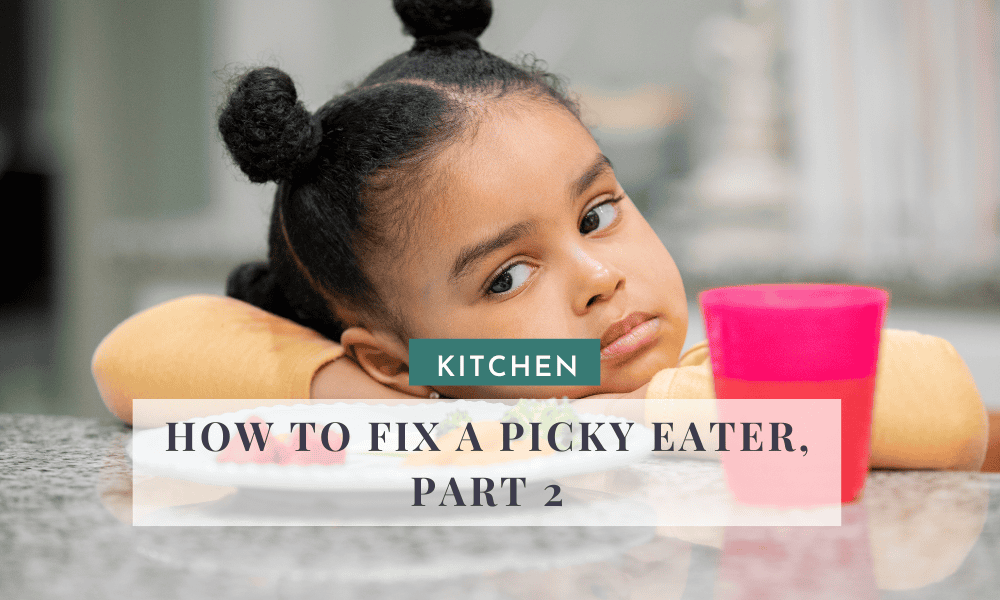In the first blog post we discussed parenting strategies for reforming picky eaters, and now it’s time to discuss actual food strategies that will help. Remember, the ultimate goal here is to help your children develop a broad and adventurous palate…not just for your own sake as the Mom who has turned into a short order cook, but for their own sakes.
Being an adventurous eater will benefit them in so many ways, not just as guests in other people’s homes, but also because the world of food is so amazing!
Food Strategy 1- Non Casserole Meals
Ahh, the beauty and convenience of one pot meals…you’ve got your meat, your starch, and your veg all in one dish. Could anything be easier to serve to your busy, hungry family?
Listen, I was born in Alabama, so you know that my Mama was cooking up casseroles at least five out of seven days of the week. And we ate what was served. And we liked it.
And to this day, even though I thoroughly enjoy fancy dishes, casseroles are comfort food.
So it came as a huge shock to me to discover that one thing that a lot of picky eaters don’t enjoy is the humble casserole. It’s not necessarily the individual ingredients in the casserole, just the fact that they are all mixed together.
So in the early days of trying to expand your children’s palate and get them to try and enjoy different foods, splitting the foods up is a great idea.
It’s not necessarily any extra work, you’re just keeping the same foods separate. So instead of a broccoli chicken and rice casserole, serve the broccoli, chicken, and rice separate, have some shredded cheese on the side that the child can choose to add to the top of any of those foods, maybe also set out a few different sauces that the child could choose to add and see how that goes.
After the child has accepted each individual ingredient, you can try again with the casserole.
Food Strategy 2- Removing Ultra Processed Foods From The House
Have you ever wondered why your child will only eat chicken nuggets and pizza rolls (or whatever processed food your child prefers)? Why, oh why can’t they decide they will only eat grilled chicken and carrot sticks?
It’s because food companies aren’t playing fair. There are some extra ingredients added to the foods to make them hyper palatable…in other words, they will make your child want more. If your child is getting processed foods on a regular basis, regular, healthy, whole foods are just not going to be exciting at all!
So how do we fix this? Easy. Just stop buying processed foods.
Now I know that it’s not actually that easy. The thing about processed food is that it’s convenient!
But right off the top of my head I can think of three reasons to just quit buying it:
- You’ll save money, processed food costs more
- Your child’s taste buds will adjust faster to healthy whole food
- Your child will be healthier
Food Strategy 3- Limit Snack Times
You know the weight loss diet saying “If you’re not hungry enough for an apple, you’re not hungry!” Well, this mindset can help you with your picky eaters.
Cut out the afternoon snack time. If your child isn’t actually hungry at dinner time, he will be much less likely to try a food he has previously turned down. If he is actually hungry though, this will work to your benefit.
I am of course not advocating for starving your children, but cutting out afternoon snacks until your child has learned to try new foods and eat what is served for dinner will be a helpful tool in your toolbox.
Food Strategy 4- Continual Exposure
While you are working with your child to banish the picky eating habits, I would suggest you stick to a tight meal rotation for a few weeks. Keep serving the same 5-7 dinners, every week until your child has built up a tolerance for the food.
Once your child has mastered one dish, introduce a new one, but keep it tight for the first few weeks and months. Studies show that a child needs to try a new food eight to fifteen times before he accepts it.
Most parents are just giving up too soon after three to five tries.
Commit to the long haul!
Food Strategy 5- Try A Few Bites
This is one of my favorite strategies for a variety of reasons. This strategy “holds space” for the fact that there are some foods that people will just not ever enjoy and that’s okay. It also teaches the technique behind eating something anyway with gladness and thanksgiving even if it isn’t your preference…this is a life skill.
I have one child who really does not enjoy tomato based sauces…this ranges from marinara to chili. Unfortunately for him, we have pasta with marinara weekly, and in the fall and winter, we have quite a lot of chili.
I wanted this child to learn to eat what is served to him…he’s been exposed to it WAY more than fifteen times, so I don’t think it will ever be a meal that he relishes. He has actually learned to enjoy pizza, so that is progress.
He is nine now, and for at least the last year, he will give himself a small serving (at least three bites), and he will put extra salad on his plate so that he isn’t hungry. And THIS is how any adult would or at least should handle this type of scenario when eating at another person’s home.
Barring food allergies, an adult should be able to go have dinner at another person’s home, and eat what is served without any drama. And the way to do that is with a smaller portion of the food that isn’t preferred, with extra of other foods. No need to draw attention, etc.
And since this is what my nine year old now does, I don’t consider him to be a picky eater any longer. He has learned how to handle food situations with grace, and that was the goal all along!
So the starting point for this is to require that your child eat at least three bites of everything that is being served. If you have a child who has a particularly strong dislike of certain foods, then start with one bite and have three bites be the goal. Work your way up!
Food Strategy 6- Dessert As Incentive
This strategy is another favorite, and it works like magic if you pair it with food strategy 5. Use dessert as an incentive!
Before I discovered this strategy we rarely offered dessert. However, once I discovered how helpful this strategy could be, I started having a small dessert option at just about every meal.
This doesn’t have to be elaborate, and the serving doesn’t need to be large. You could even keep it as simple as a Reese’s cup. But use it strategically.
In our home, dessert is only given to people who have finished their dinner. So, if you choose to only take three bites of your casserole, and there are still a few bites on your plate, you’ll need to make a decision.
And it is 100% the child’s choice. There’s no need for additional pressure or persuasion. This is a very matter-of-fact transaction. Clean plates result in dessert. You may choose to leave food on your plate, but that means you don’t get dessert.
And that’s how it works!
Keep in mind as you try out these different strategies that this is not a quick fix. Teaching your child good eating habits takes time, lots of time, but also lots of patience.
If you treat this like you would treat other important issues ie. looking both ways before crossing the street, buckling your seatbelt, etc. it will help you to dedicate the time and the right attitude towards the task.
Remember, it all starts with parenting, but these picky eater strategies will help you achieve the goal with less stress.







